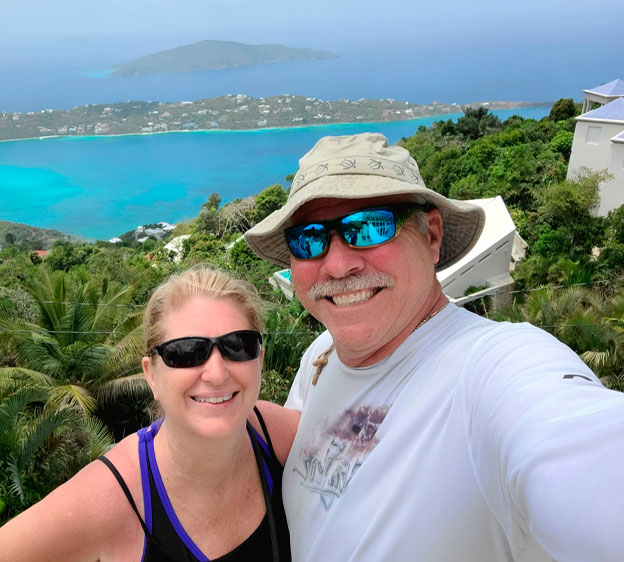John Aust: On the Go Again After Double Knee Replacement
August 15, 2023
 At the age of 56, John Aust’s knees literally brought him to his knees. His early years as a tree service owner and later years in mobile home construction had taken their toll. He was in constant pain, his knees were “basically bone on bone,” and they were slowing him down.
At the age of 56, John Aust’s knees literally brought him to his knees. His early years as a tree service owner and later years in mobile home construction had taken their toll. He was in constant pain, his knees were “basically bone on bone,” and they were slowing him down.
But for this successful Beaufort real estate agency owner and avid world traveler, who "wouldn’t sleep if I didn’t have to," staying on his knees was no longer an option. Aust was miserable and exhausted all conservative measures.
So last year, Aust got two new knees: the left knee was replaced in March and the right knee in October.
“I was hoping I could make it to 60 without the knee replacements, but I didn’t want to wait,” recalls Aust. “I had too many things to do and too many places to go, go, go!”
Read More: New Knees and a New Lease on Life
Considerations Before Joint Replacement
 The improved engineering of the implants typically used in today’s total knee replacements has led to better durability. All options were exhausted before settling on total replacement.
The improved engineering of the implants typically used in today’s total knee replacements has led to better durability. All options were exhausted before settling on total replacement.
“When I see someone in their 50s, I still think it’s important to try conservative measures first,” says Dr. Vandit Sardana, a board-certified, fellowship-trained orthopedic surgeon at Beaufort Memorial Orthopaedic Specialists. “However, if those measures aren’t working and the person’s quality of life is suffering due to their arthritic symptoms, then joint replacement surgery is probably indicated.”
Because of Aust’s comparatively young age, the longevity of the replacements was a key consideration.
“Historically, we’ve recommended the ideal age for joint replacement surgery to be 60 to 65 or older,” Dr. Sardana says. “And with the Mako robotic-arm assisted surgery system, I can more closely customize the ideal position of the knee implant, which should also increase its longevity.”
Aust was enthusiastic.
“I didn’t know anything about Mako robotic knee replacement surgery, but when I was told it could help me get back to the life I loved even faster, that sounded great to me,” he says.
Read More: Lowcountry Couple’s Joint Adventure
Advanced Robotic Procedures
The leading-edge Mako system, which Beaufort Memorial first introduced to the Lowcountry over three years ago, allows orthopedic surgeons to create a surgical plan unique to a patient’s anatomy. The robotic arm is used to implant the components with greater precision, leading to better function and more natural movement.
A CT scan creates a 3D virtual model of the patient’s unique joint. The surgeon then evaluates the model's bone structure, disease severity, joint alignment, and the surrounding bone and tissue to determine the optimal size, placement and alignment of the implant. Less irritation of the soft tissues often translates to less post-operative pain and a faster return to normal activities, with some patients going home the day of their surgery.
“During the operation, we follow the preoperative plan, guiding the robotic arm to remove arthritic bone and cartilage and position the prosthetic joint,” Dr. Sardana explains. “A virtual boundary established by the robot prevents us from crossing the bone field into the surrounding soft tissues.”
Read More: From OR to RV: Enjoying Life After Knee Replacement
‘Sooner Rather Than Later’
 “Go, go, go” is what John Aust does every single day, so he was thrilled when, a few hours after his first knee replacement surgery, after he successfully walked down the hallway and steps at Beaufort Memorial, he was allowed to go home. He admits, however, that once the pain medication wore off, the first few post-surgery days were a bit rough.
“Go, go, go” is what John Aust does every single day, so he was thrilled when, a few hours after his first knee replacement surgery, after he successfully walked down the hallway and steps at Beaufort Memorial, he was allowed to go home. He admits, however, that once the pain medication wore off, the first few post-surgery days were a bit rough.
“I wasn’t in the best physical shape at the time, and I think that slowed down my first recovery process,” he says. “But when I could, I started going to the gym five days a week. I was very self-motivated, and six months later, the second knee surgery recovery process was a whole different story. I was really good in record time the second time around.”
John did great after his initial knee replacement but did even better after the second. He was really motivated and pushed himself to get in shape both before and after his second surgery.
 In Aust’s case, that motivation has led to a return to doing the things he enjoys in record time. He and his wife, Kim, have planned an adventuresome travel itinerary this fall that includes a trip to Egypt and a balloon ride over the pyramids. And he credits Beaufort Memorial and Mako SmartRobotics for bringing him back up from his knees.
In Aust’s case, that motivation has led to a return to doing the things he enjoys in record time. He and his wife, Kim, have planned an adventuresome travel itinerary this fall that includes a trip to Egypt and a balloon ride over the pyramids. And he credits Beaufort Memorial and Mako SmartRobotics for bringing him back up from his knees.
“I’m glad I did it sooner rather than later,” he says. “My quality of life is 100% improved. I walk a lot when we travel, lots of steps, and I really enjoy it now. I walk straighter and I walk taller.”
Ready to find lasting relief for your joint pain? Register for an upcoming Solving Hip and Knee Pain seminar or request an appointment with an orthopedic specialist.

